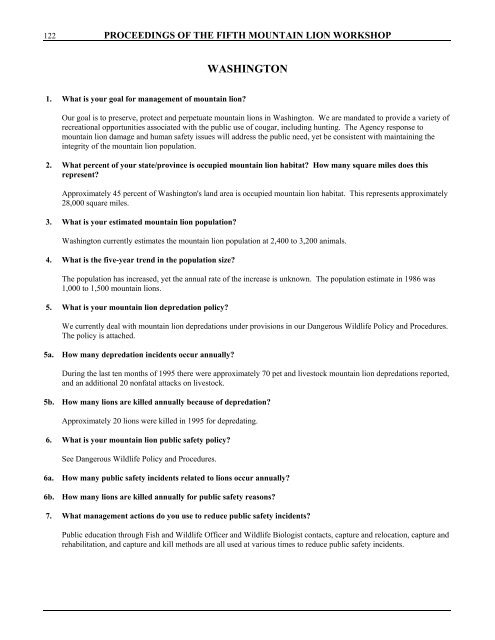Proceedings of the fifth mountain lion workshop: 27
Proceedings of the fifth mountain lion workshop: 27
Proceedings of the fifth mountain lion workshop: 27
You also want an ePaper? Increase the reach of your titles
YUMPU automatically turns print PDFs into web optimized ePapers that Google loves.
122 PROCEEDINGS OF THE FIFTH MOUNTAIN LION WORKSHOP<br />
1. What is your goal for management <strong>of</strong> <strong>mountain</strong> <strong>lion</strong>?<br />
WASHINGTON<br />
Our goal is to preserve, protect and perpetuate <strong>mountain</strong> <strong>lion</strong>s in Washington. We are mandated to provide a variety <strong>of</strong><br />
recreational opportunities associated with <strong>the</strong> public use <strong>of</strong> cougar, including hunting. The Agency response to<br />
<strong>mountain</strong> <strong>lion</strong> damage and human safety issues will address <strong>the</strong> public need, yet be consistent with maintaining <strong>the</strong><br />
integrity <strong>of</strong> <strong>the</strong> <strong>mountain</strong> <strong>lion</strong> population.<br />
2. What percent <strong>of</strong> your state/province is occupied <strong>mountain</strong> <strong>lion</strong> habitat? How many square miles does this<br />
represent?<br />
Approximately 45 percent <strong>of</strong> Washington's land area is occupied <strong>mountain</strong> <strong>lion</strong> habitat. This represents approximately<br />
28,000 square miles.<br />
3. What is your estimated <strong>mountain</strong> <strong>lion</strong> population?<br />
Washington currently estimates <strong>the</strong> <strong>mountain</strong> <strong>lion</strong> population at 2,400 to 3,200 animals.<br />
4. What is <strong>the</strong> five-year trend in <strong>the</strong> population size?<br />
The population has increased, yet <strong>the</strong> annual rate <strong>of</strong> <strong>the</strong> increase is unknown. The population estimate in 1986 was<br />
1,000 to 1,500 <strong>mountain</strong> <strong>lion</strong>s.<br />
5. What is your <strong>mountain</strong> <strong>lion</strong> depredation policy?<br />
We currently deal with <strong>mountain</strong> <strong>lion</strong> depredations under provisions in our Dangerous Wildlife Policy and Procedures.<br />
The policy is attached.<br />
5a. How many depredation incidents occur annually?<br />
During <strong>the</strong> last ten months <strong>of</strong> 1995 <strong>the</strong>re were approximately 70 pet and livestock <strong>mountain</strong> <strong>lion</strong> depredations reported,<br />
and an additional 20 nonfatal attacks on livestock.<br />
5b. How many <strong>lion</strong>s are killed annually because <strong>of</strong> depredation?<br />
Approximately 20 <strong>lion</strong>s were killed in 1995 for depredating.<br />
6. What is your <strong>mountain</strong> <strong>lion</strong> public safety policy?<br />
See Dangerous Wildlife Policy and Procedures.<br />
6a. How many public safety incidents related to <strong>lion</strong>s occur annually?<br />
6b. How many <strong>lion</strong>s are killed annually for public safety reasons?<br />
7. What management actions do you use to reduce public safety incidents?<br />
Public education through Fish and Wildlife Officer and Wildlife Biologist contacts, capture and relocation, capture and<br />
rehabilitation, and capture and kill methods are all used at various times to reduce public safety incidents.

















